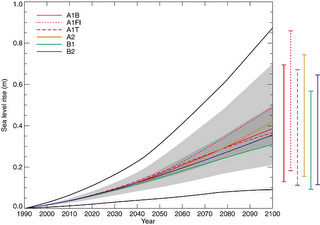Always RTFR....
Always RTFR....
Ian Castles has responded.
You ask 'was the latter even printed?' Yes, the Director of the Office of Policy Analysis of the USEPA cited three multi-authored books that had appeared in 1983, 1985 and 1987. It is common for books to be printed.
The conference was sponsored by (among others) the Climate Institute, NOAA, the US Department of Energy, the US EPA, the National Science Foundation, NASA, the World Resources Institute and UNEP in cooperation with the Participating Agencies and Universities of the Canadian Climate Program. As might be expected, the Proceedings were printed.Eli's first thought was to point out that Castles was pointing to Morgenstern's impression of a consensus not a consensus. But then I remembered RTFR. Well, I don't have it, but I can probably get it tomorrow.
In another presentation at the Conference, James Titus, Project Manager for Sea Level Rise at the EPA, presented a table showing that NASA's estimate of sea level rise was 70 cm by 2085 and that estimates by other authorieies of sea level rise to 2100 were: EPA, 56-345 cm; National Academy of Science, 50-200 cm.; and Hoffman et al, 57-368cm.
So the CONSENSUS view changed by a huge margin over a period of 13 years - it wasn't just one person's estimate
Still, Google is your friend, and you can find a lot of things if you know how to look. But before we do, let us remember that Castles claims the 1987 consensus (according to Morgenstern) was that by 2100 the global sea level will rise by 61-238 cm, while in 2000, the IPCC Third Assessment Report (TAR) consensus rise was 9-88 cm.
And gee, guess what I found. From the Intergovernmental Panel on Climate Change (IPCC). 1990. Potential impacts of climate change. Report of Working Group 2, Intergovernmental Panel on Climate Change, 1-1 to 2. Geneva: World Meteorological Organization (WMO)/United Nations Environment Programme (UNEP).
Global warming will cause a thermal expansion of the upper layers of the ocean and this expansion, together with the expected melting and movement into the ocean of some land-based glaciers, is expected to accelerate the current sea-level rise trend. A rise of 9-29 cm is expected over the next 40 years, or 28-98 cm by 2090 (Working Group I Report - Summary).That's 1990 folks, from the First Assessment Report (FAR). Right in line with the "9-88" cm rise expected in the IPCC TAR ten years later and with the US National Academy report on Responding to Changes in Sea Level: Engineering Implications (1987) That's 1987 folks, the same time that Castles claims the consensus estimate is 61-238 cm. The second chapter of the report summarizes expert opinion on global temperature increases and the associated sea level rise. It concludes:
Apply these values to an estimated temperature change of 3.5 +/- 2 C due to a doubling of greenhouse gases over the next century, and the associate range in global mean sea level change is from 24 to 154 cm.But there is more, let us go to the TAR, Figure 11.-2.
 As the caption explains "The region in dark shading shows the range of the average of AOGCMs for all 35 SRES scenarios. The region in light shading shows the range of all AOGCMs for all 35 scenarios. The region delimited by the outermost lines shows the range of all AOGCMs and scenarios including uncertainty in land-ice changes, permafrost changes and sediment deposition" In other words, the dark shaded region (30-50 cm) is the most likely, the gray shaded region (20-70 cm) is somewhat least likely and the region between the two black lines (9-88 cm) encompasses the full range of possibilities. The core estimates are quite close to the FAR 28 - 98 cm. The high end estimate of 154 cm from the 1987 National Academy report has come down significantly, but then again the upper temperature limit from that report was 5.5 C as opposed to the 5.1 of the TAR.
As the caption explains "The region in dark shading shows the range of the average of AOGCMs for all 35 SRES scenarios. The region in light shading shows the range of all AOGCMs for all 35 scenarios. The region delimited by the outermost lines shows the range of all AOGCMs and scenarios including uncertainty in land-ice changes, permafrost changes and sediment deposition" In other words, the dark shaded region (30-50 cm) is the most likely, the gray shaded region (20-70 cm) is somewhat least likely and the region between the two black lines (9-88 cm) encompasses the full range of possibilities. The core estimates are quite close to the FAR 28 - 98 cm. The high end estimate of 154 cm from the 1987 National Academy report has come down significantly, but then again the upper temperature limit from that report was 5.5 C as opposed to the 5.1 of the TAR.You really do have to RTFR with these guys.





1 comment:
Dear Eli Rabbett,
I came accross this discussion after a colleague sent me a link to your discussion of Captain Sea Level's little analysis on adaptation to global warming and Arctic climate change. I worked for Dick Morgenstern 1982-1993 and have a few additional related facts that probably support what both you and Mr. Castles said on the jennifermarohasy blog. Not sure whether to just post to that blog since it is 2 weeks old--I don't have email for either of you but you probably have my home email which would be pronounced as
J Titus spamm at Erols spamm dot com
except remove the spamm.
Best regards,
Jim
Post a Comment